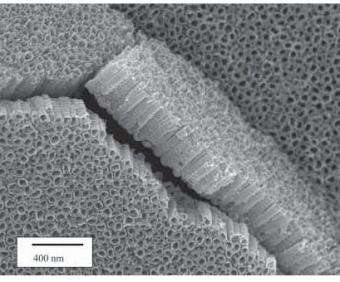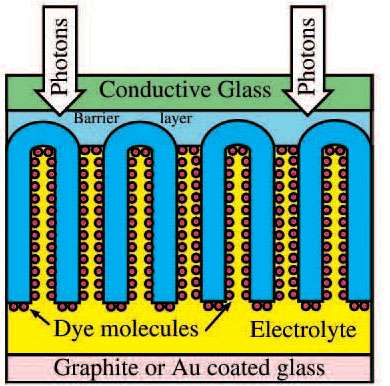Titania Nanotube Arrays Harness Solar Energy

Penn State researchers are finding new ways to harness the power of the sun using highly-ordered arrays of titania nanotubes for hydrogen production and increased solar cell efficiency.
Creating a renewable energy resource to supplement and ultimately replace dwindling petroleum reserves is one of the pressing needs our nation faces within our own and our children’s lifetimes. But gasoline, an almost perfect fuel, with a tremendous amount of power contained in a small cupful, is not easy to replace.
One of the most likely prospects for an efficient renewable resource is solar energy, either to produce hydrogen, the third most abundant element on the earth’s surface, or to power solar cells. At Penn State University, researchers are finding new ways to harness the power of the sun using highly-ordered arrays of titania nanotubes for hydrogen production and increased solar cell efficiency.
“This is an amazing material architecture for water photolysis,” says Craig Grimes, professor of electrical engineering and materials science and engineering. Referring to some recent finds of his research group (G. K. Mor, K. Shankar, M. Paulose, O. K. Varghese, C. A. Grimes, Enhanced Photocleavage of Water Using Titania Nanotube-Arrays, Nano Letters, vol. 5, pp. 191-195.2005 ), “Basically we are talking about taking sunlight and putting water on top of this material, and the sunlight turns the water into hydrogen and oxygen. With the highly-ordered titanium nanotube arrays, under UV illumination you have a photoconversion efficiency of 13.1%. Which means, in a nutshell, you get a lot of hydrogen out of the system per photon you put in. If we could successfully shift its bandgap into the visible spectrum we would have a commercially practical means of generating hydrogen by solar energy. It beats fighting wars over middle-eastern oil.”

The highly ordered nanotube arrays also demonstrate remarkable properties when used in solar cells, as reported in the Vol. 6 No. 2 issue of Nano Letters; the Grimes’ team, which includes Gopal K. Mor, Karthik Shankar, Maggie Paulose, and Oomman K. Varghese, describes the initial results of their application of highly-ordered transparent titania nanotubes on the negative electrode in dye solar cells. This type of solar cell shows great promise as a relatively low cost solution to efficiently producing electricity from the sun.
According to the authors, the highly ordered nanotube arrays provide excellent pathways for electron percolation, in effect acting as ‘electron highways’ for directing the photo-generated electrons to where they can do useful work. Their results suggest that highly-efficient dye solar cells could be made simply by increasing the length of the nanotube arrays. Grimes and colleagues feel that solutions to this and other processing issues are within reach and will result in a considerable, possibly quite dramatic increase in solar cell efficiency.
On the web: www.mri.psu.edu
Source: Penn State

















